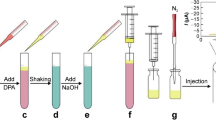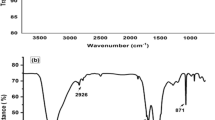Abstract
CeO2-encapsulated gold nanoparticles (AuNPs) were anchored to reduced graphene oxide (RGO/Au@CeO2) by an interfacial auto-redox reaction in a solution containing tetrachloroauric acid and Ce(III) on a solid support. The resulting material was placed on a glassy carbon electrode (GCE) and used as an electrochemical hydrazine sensor at trace levels. The electrocatalytic activity of the modified GCE towards hydrazine oxidation was significantly enhanced as compared to only RGO/CeO2, or CeO2-encapsulated AuNPs, or AuNPs loaded on CeO2 modified with RGO. This enhancement is attributed to the excellent conductivity and large surface area of RGO, and the strong interaction between the reversible Ce4+/Ce3+ and Auδ+/Au0 redox systems. The kinetics of the hydrazine oxidation was studied by electrochemical methods. The sensor, best operated at a peak voltage of 0.35 V (vs. saturated calomel electrode), had a wide linear range (that extends from 10 nM to 3 mM), a low detection limit (3.0 nM), good selectivity and good stability. It was successfully employed for the monitoring of hydrazine in spiked environmental water samples and to in-vitro tracking of hydrazine in cells with respect to its potential cytotoxicity.

CeO2-encapsulated gold nanoparticles anchored on reduced graphene oxide with the strong interaction between the reversible Ce4+/Ce3+ and Auδ+/Au0 reductions can be used for sensitive detection of hydrazine with detection limit of 3 nM and good selectivity in environmental and biological samples.






Similar content being viewed by others
References
Amiripour F, Azizi SN, Ghasemi S (2018) Gold-copper bimetallic nanoparticles supported on nano P zeolite modified carbon paste electrode as an efficient electrocatalyst and sensitive sensor for determination of hydrazine. Biosens Bioelectron 30:111–117
Ju ZY, Li DP, Zhang D, Li DD, Wu CZ, Xu ZH (2017) An ESIPT-based fluorescent probe for hydrazine detection in aqueous solution and its application in living cells. Microchim Acta 27:679–687
Environmental Protection Agency (EPA) (1999) Integrated risk information system (IRIS) on hydrazine/hydrazine sulfate, in: national center for environmental assessment, office of research and development. Washington DC
Iranifam M (2016) Chemiluminescence reactions enhanced by silver nanoparticles and silver alloy nanoparticles: applications in analytical chemistry. Anal Chem 82:126–142
Han Q, Aydan T, Yang L, Zhang X, Liang Q, Ding M (2018) In-syringe solid-phase extraction for on-site sampling of pyrethroids in environmental water samples. Anal Chim Acta 1009:48–55
Lu Z, Shi X, Ma Y, Fan W, Lu Y, Wang Z (2018) A simple two-output near-infrared fluorescent probe for hydrazinedetection in living cells and mice. Sensors Actuators B Chem 258:42–49
Chen Y, Xian YY, Jiang X (2017) Surface modification of gold nanoparticles with small molecules for biochemical analysis. Acc Chem Res 50:310–319
Yao TH, Guo X, Qin S-C, Xia FY, Li YL, Chen Q, Li JS, He DY (2017) Effect of RGO coating on interconnected Co3O4 nanosheets and improved supercapacitive behavior of Co3O4/rGO/NF architecture. Nano-Micro Lett. 9:38
Rahman MM, Alfonso VG, Fabregat-Santiago F, Bisquert J, Asiri AM, Alshehri AA, Albar HA (2017) Hydrazine sensors development based on a glassy carbon electrode modified with a nanostructured TiO2 films by electrochemical approach. Microchim Acta 184:2123–2129
Du JS, Bian T, Yu J, Jiang Y, Wang X, Yan Y, Jiang Y, Jin C, Zhang H, Yang D (2017) Embedding ultrafine and high-content Pt nanoparticles at ceria surface for enhanced thermal stability. Adv Sci 4(2017):1700056
Li S, Bao D, Shi M, Wu B-L, Yan J, Jiang Q (2017) Amorphizing of Au nanoparticles by CeOx-RGO hybrid support towards highly efficient electrocatalyst for N2 reduction under ambient conditions. Adv Mater 29:1700001
Jin R, Zeng C, Zhou M, Chen Y (2016) Atomically precise colloidal metal nanoclusters and nanoparticles: fundamentals and opportunities. Chem Rev 116:10346–10413
Zhan W, He Q, Liu X, Guo Y, Wang Y, Wang L, Guo Y, Borisevich A-Y, Zhang J, Lu G, Dai S (2016) A sacrificial coating strategy toward enhancement of metal–support interaction for ultrastable Au nanocatalysts. J Am Chem Soc 138:16130–16139
Mitsudome T, Mikami Y, Matoba M, Mizugaki T, Jitsukawa K, Kaneda K (2012) Design of a silver-cerium dioxide core–shell nanocomposite catalyst for chemoselective reduction reaction. Angew Chem Int Ed 51:136–139
Han YJ, Han L, Zhang LL, Dong SJ (2015) Ultrasonic synthesis of highly dispersed Au nanoparticles supported on Ti-based metal-organic frameworks for electrocatalytic oxidation of hydrazine. J Mater Chem A 3:14669–14674
Jiao Y, Li N, Yu H, Li W, Zhao J, Li X, Zhang X (2017) Fabrication of strawberry-like Au@CeO2 nanoparticles with enhanced catalytic activity by assembly of block copolymer composite micelles. RSC Adv 7:662–668
Song S, Wang X, Zhang H (2015) CeO2-encapsulated noble metal nanocatalysts: enhanced activity and stability for catalytic application. NPG Asia Material 7:179
Wang F, Wang J, Shao L, Zhao Y, Xia X (2014) Hybrids of gold nanoparticles highly dispersed on graphene for the oxygen reduction reaction. Electrochem Commun 38:82–85
Zhang C, Wang G, Ji Y, Liu M, Feng Y, Zhang Z (2010) Enhancement in analytical hydrazine based on gold nanoparticles deposited on ZnO-MWCNTs films. Sensors Actuators B Chem 150:247–253
Ismail RA, Abdul-Hamed R (2017) Laser ablation of Au–CuO core–shell nanocomposite in water for optoelectronic devices. Mater Res Express 4:125020
Ye W, Yang B, Cao G, Duan L, Wang C (2008) Electrocatalytic oxidation of hydrazine compound on electroplated Pd/WO3 film. Thin Solid Films 516:2957–2961
Costa WM, Marques AB, Marques EP, Bezerra CB, Sousa ER, Cardoso WS, Song CJ, Zhang JJ (2010) Hydrazine oxidation catalyzed by ruthenium hexacyanoferrate-modified glassy carbon electrode. J Appl Electrochem 40:375–382
Zhao Z, Xia Z, Liu C, Huang H, Ye W (2017) Green synthesis of Pd/Fe3O4 composite based on polyDOPA functionalized reduced graphene oxide for electrochemical detection of nitrite in cured food. Electrochim Acta 256:146–154
Abdel-mageed A, Kucerova G, Bansmann J, Behm R (2017) Active Au species during the low-temperature water gas shift reaction on Au/CeO2: a time-resolved operando XAS and DRIFTS study. ACS Catal 7:6471–6484
Wang H, Thia L, Li N, Ge X, Liu Z, Wang X (2015) Selective electro-oxidation of glycerol over Au supported on extended poly(4-vinylpyridine) functionalized graphene. Appl Catal B Environ 166:25–31
Bard A, Faulkner L (2001) Fundamentals and application in: electrochemical method. Wiley New York
Benvidi A, Jahanbani S, Mirjalili B, Zare R (2016) Electrocatalytic oxidation of hydrazine on magnetic bar carbon paste electrode modified with benzothiazole and iron oxide nanoparticles: simultaneous determination of hydrazine and phenol. Chin J Catal 37:549–560
Pournaghi-Azar M, Sabzi R (2003) Electrochemical characteristics of a cobalt pentacyanonitrosylferrate film on a modified glassy carbon electrode and its catalytic effect on the electrooxidation of hydrazine. J Electroanal Chem 543:115–125
Zhu Y, Sigdel A, Zhang S, Su D, Xi Z, Li Q, Sun H (2014) Angew Chem Int Edit 126:12716–12720
Hamidi H, Bozorgzadeh S, Haghighi B (2017) Amperometric hydrazine sensor using a glassy carbon electrode modified with gold nanoparticle-decorated multiwalled carbon nanotubes. Microchim Acta 184:4537–4543
Guo W, Ma J, Cao X, Tong X, Liu F, Liu Y, Liu S (2017) Amperometric sensing of hydrazine using a magnetic glassy carbon electrode modified with a ternary composite prepared from Prussian blue, Fe3O4 nanoparticles, and reduced graphene oxide. Microchim Acta 184:3163–3170
Yang Z, Sheng Q, Zhang S, Zheng X, Zheng J (2017) One-pot synthesis of Fe3O4/polypyrrole/graphene oxide nanocomposites for electrochemical sensing of hydrazine. Microchim Acta 184:2219–2226
Rahman MM, Khan A, Marwani HM, Asiri AM (2016) Hydrazine sensor based on silver nanoparticle-decorated polyaniline tungstophosphate nanocomposite for use in environmental remediation. Microchim Acta 183:1787–1796
Rahman MM, Alam MM, Asiri AM (2018) Selective hydrazine sensor fabrication with facile low-dimensional Fe2O3/CeO2 nanocubes. New J Chem 42:10263–10270
Acknowledgements
This work is supported by the Fundamental Research Fund for the Central Universities (Nos. lzujbky-2017-k9) and the Natural Science Foundation of Gansu Province, China (No. 17JR5RA209).
Author information
Authors and Affiliations
Corresponding authors
Ethics declarations
The author(s) declare that they have no competing interests.
Additional information
Publisher’s Note
Springer Nature remains neutral with regard to jurisdictional claims in published maps and institutional affiliations.
Electronic supplementary material
ESM 1
(DOC 2904 kb)
Rights and permissions
About this article
Cite this article
Huang, H., Li, T., Sun, Y. et al. Amperometric sensing of hydrazine in environmental and biological samples by using CeO2-encapsulated gold nanoparticles on reduced graphene oxide. Microchim Acta 186, 46 (2019). https://doi.org/10.1007/s00604-018-3144-4
Received:
Accepted:
Published:
DOI: https://doi.org/10.1007/s00604-018-3144-4




